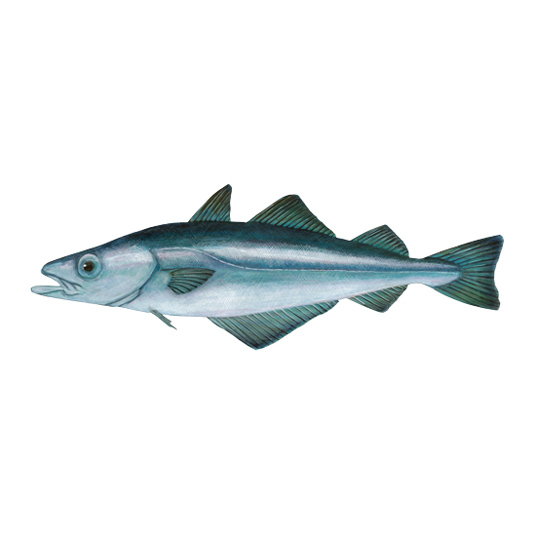

Pollack are closely related to cod, and they can grow very big! Their flesh is not as white in colour but is very similar in taste and texture to cod. They live near to the sea bed around rocky reefs and wrecks. Pollack is becoming increasingly popular, and prices can be high, partly due to the irregular supplies of this popular fish which is not easy to catch. Look out for handline caught pollack which is the highest quality and most sustainable option available.
Pollack are a species facing threats from both fishing and climate change. As a result, this species is struggling in Cornish waters. ICES has advised that there should be 'zero catch', when applying our rating methodology pollack is a critical fail and is rated 5 - the least sustainable rating.
Pollack caught with hook and line are the most sustainable option for buyers and using this method is far better than fishing for pollack with gill nets as the rough ground they prefer - reefs and wrecks - often results in loss of nets and ghost fishing.
In 2021 a total of 568 tonnes of Pollack were landed to Cornish ports with a value of £1.6 million (MMO data).
Updated October 2023
Cornish vessels landing to Cornish ports
Handlining is a simple fishing method where hooks on lines are used to catch fish in a very traditional and sustainable way.
Learn moreCornish waters VIIe, f, g and h
Gill nets are lightweight nets made of nylon (monofilament) fishing line that are anchored to the seabed and are used to catch fish by entangling the gills.
Learn moreCornish waters VIIe, f, g and h
Demersal trawls are large nets that are pulled through the water with the bottom edge of the net touching the seabed.
Learn moreCornwall Good Seafood Guide rates fish on sustainability using a scale of 1 to 5.
1, 2 and 3 are recommended, Fish to avoid are rated 5.
We use the system devised by the Marine Conservation Society (MCS) so our scores are comparable with the scores produced by MCS for the UK and fisheries from all around the world. For more information on scoring click here.
Distributed throughout the northeast Atlantic, pollack is a temperate species belonging to the gadoid (cod) family. It is mostly found close to the shore with a preference for wrecks and rocky bottom. It usually occurs at 40-100 m depth but is found down to 200m. Growth is rapid, approaching 10 cms per year. It migrates into deeper water as it grows. Maturity occurs at approximately 3 years. It spawns between January and April. Young of the first year are particularly common close inshore and may therefore be protected from fisheries in the early life stages. This species can reach a length of 120-130cm. A maximum size of 130 cm, a maximum weight of 18 kg and a maximum age of 15 years are reported. Many gadiod species are having poor recruitment as a result of climate change, and this could be a major cause of the population decline seen in this species. Pollack are moderately vulnerable to fishing 59% (Chueng et al 2005), although their resilience is Medium (fishbase).
Pollack are a difficult species to survey as they live near reefs and wrecks and are thus not easily surveyed using typical trawl methods. There is also a considerable amount of recreational fishing for pollack which is not quantified at all.
ICES has now benchmarked a new full stock assessment with better scientific evidence which shows that the pollack stock biomass (population size) is well below MSY, with fishing pressure above sustainable levels since 2012. This new data has led to a revised perception of the stock. MMO landings data shows that catches landed to Cornish ports had remained fairly constant, fluctuating at around 1000 tonnes per year but with a downturn in 2016, when 1198 tonnes were landed to fluctuating around 600 more recently. Recreational landings of pollack are un-recorded but are thought to be large (up to 3000 tonnes in area 7).
Catches are limited by a quota set by the EU common fisheries policy. There is a minimum landing size of 30cm. The quota set has been much higher than ICES advice for the Celtic sea but landings have been well below the quota - so this quota currently does not seem to be limiting fishing effort. Overall landings have been below levels advised by ICES.






Cornwall Good Seafood Guide is underpinned by the Marine Conservation Society (MCS) Good Fish Guide. The first UK consumer guide to sustainable seafood. For more information visit www.fishonline.org
Cornwall Good Seafood Guide is here to help us all make sustainable seafood choices. Choices that will help us keep the oceans healthy and Cornish fishers' futures safe. This website is funded by Cornwall Wildlife Trust. If you would like to make a meaningful difference to the health of our oceans, please consider making a donation to the Cornwall Wildlife Trust Ocean Emergency fund. Your donation will help safeguard these remarkable environments, ensuring that they continue to thrive for generations to come. Together, we can be stewards of the seas and champions for a healthier, more sustainable future.